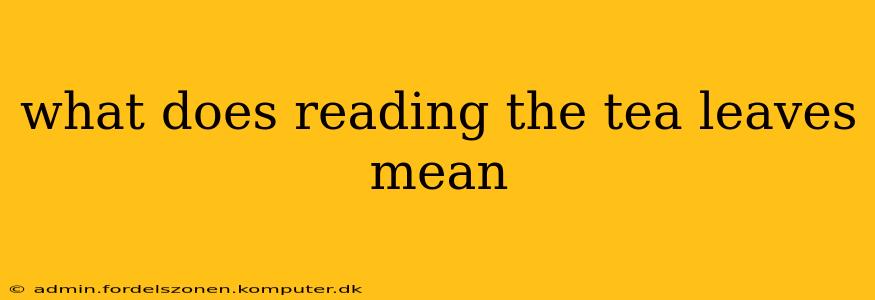Reading tea leaves, also known as tasseography, is an ancient form of divination. It's the practice of interpreting patterns and symbols formed by the leftover tea leaves at the bottom of a teacup. While often romanticized, it's important to understand that tasseography is considered a form of entertainment and shouldn't be relied upon for making significant life decisions. However, the process can be a fun and insightful way to explore your intuition and reflect on your life.
What are the Origins of Tea Leaf Reading?
The origins of tea leaf reading are somewhat shrouded in mystery, but many trace it back to ancient China, possibly as far back as the Tang Dynasty (618-907 AD). Tea was already a significant part of Chinese culture, and the practice of looking for meanings in the remnants likely evolved naturally from a close observation of the leaves themselves. Over time, it spread along trade routes, eventually making its way to Europe and other parts of the world. Different cultures adapted and interpreted the symbols in their own unique ways, adding layers of complexity and tradition to the practice.
How Do You Read Tea Leaves?
The process involves steeping loose leaf tea—not tea bags—in a cup, preferably a light-colored cup to aid visibility. After drinking most of the tea, you gently swirl the remaining liquid to distribute the leaves evenly. Then, you turn the cup upside down onto your saucer and carefully lift it. The patterns and shapes formed by the settled leaves are then interpreted. The positioning of the leaves—at the bottom, sides, or handle of the cup—is also considered significant, adding another layer of complexity to the reading.
What Do the Symbols in Tea Leaf Reading Mean?
There isn't a single, universally accepted guide to tea leaf symbolism. Interpretations often vary based on the reader's intuition, experience, and the specific cultural context. However, some common symbols and their potential meanings include:
- Animals: Often represent qualities or influences in your life. For example, a bird might signify freedom, while a snake could represent transformation or hidden dangers.
- Shapes: Geometric shapes or abstract forms can have symbolic meaning. A circle might represent wholeness or completion, while a cross could suggest challenges or obstacles.
- Numbers: Numbers can carry numerological significance, adding another layer of interpretation.
- Letters: The appearance of letters could point to names or initials of significant people in your life.
What are the Different Types of Tea Leaves Used?
While any loose leaf tea can technically be used, some believe certain types of tea are better suited for tasseography. Black tea is a popular choice due to its strong leaves that create distinct patterns. However, other types of tea, such as green tea or herbal infusions, can also be used depending on personal preference and the reader’s experience. The key is to use loose leaves, not tea bags, for optimal results.
Is Tea Leaf Reading Accurate?
The accuracy of tea leaf reading is subjective and heavily dependent on the interpreter's skill and intuition, as well as the individual's openness to interpretation. It's more about introspection and gaining a new perspective than receiving a definitive prediction of the future. Remember, it's a tool for self-reflection and exploration, not a guarantee of future events.
Can Anyone Learn to Read Tea Leaves?
While some people might have a natural aptitude for interpreting symbols, anyone can learn the basics of tea leaf reading. It requires patience, practice, and an open mind. Many books and online resources provide guidance on identifying symbols and interpreting patterns. It is a skill developed over time through dedicated practice and honing one's intuition.
Is Tea Leaf Reading the Same as Tasseomancy?
While often used interchangeably, there is a slight difference. Tasseomancy is a broader term referring to divination using the sediments left in a cup, while tasseography specifically refers to the divination done with tea leaves. Coffee grounds reading is another form of tasseomancy.
In conclusion, reading tea leaves is a fascinating and potentially insightful practice, but it's vital to approach it with a healthy dose of skepticism and a focus on personal reflection. Its true value lies not in predicting the future but in prompting introspection and exploring the nuances of one's own inner world. Remember, it is a practice best suited for entertainment and personal growth rather than a means for making critical decisions.
